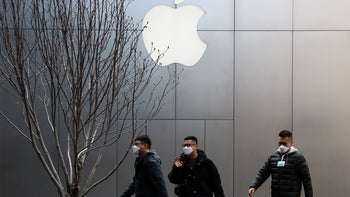Bank of America: Coronavirus disruptions to delay the 5G Apple iPhone 12, iPhone 9

With the coronavirus being on the verge of becoming a global pandemic, the mobile industry is yet another minor link in the chain of disruption that will likely ravage 2020. The COVID-19 coronavirus has already caused a serious hit on the stock market, and from the looks of it, we should brace for other Industries to be distributed. Just the other day, the Bank of America issued a report suggesting that the disruptions caused by the coronavirus could negatively affect not only the soon-to-be-announced iPhone 9, but also the 5G-enabled crop of the iPhone 12 series that's due to be announced this September.
9To5Mac reports that Bank of America's Elliot Lan expects the iPhone 12-series to be delayed by a month due to the coronavirus outbreak, meaning it would likely hit the shelves in late October. This would be quite disruptive for Apple, as the iPhone 12-series will be quite the important milestone release - it is expected to be the first 5G-ready iPhone generation, and Apple doesn't really need any delays.
Bank of America also expects the iPhone 9 (née iPhone SE2) to be negatively affected by the coronavirus outbreak as well. Mr Lan expects the iPhone 9 to be pushed back “by a few months” thanks to “both supply issues as well as the weaker demand environment from COVID-19.” Some component orders for the device have reportedly been pushed back, which could hypothetically turn the late March launch of the device an April one in the best case scenario. Of course, there's nothing stopping Apple from announcing the iPhone 9 on March 31 as we originally expected, but the actual market launch most certainly won't be simultaneous.
As a refresher, the iPhone 9 has been a long time in the making, as the preceding iPhone SE was released all the way back in March 2016. In terms of overall hardware, the phone is expected to be a mix between the iPhone 8's design and the iPhone 11's hardware, which would make it quite the compact powerhouse.
Rumors peg the pricing for the 64GB iPhone 9 will cost $399 for the base version, while the 128GB variation could fetch a $449 price tag. This pricing, paired with the popularity of the original iPhone SE, made popular Apple leakster and analyst Ming-Chi Kuo to initially project between 30 and 40 million potential sales of the powerful munchkin, but recent delays have toned down this projection all the way down to 20-30 million sales.
9To5Mac reports that Bank of America's Elliot Lan expects the iPhone 12-series to be delayed by a month due to the coronavirus outbreak, meaning it would likely hit the shelves in late October. This would be quite disruptive for Apple, as the iPhone 12-series will be quite the important milestone release - it is expected to be the first 5G-ready iPhone generation, and Apple doesn't really need any delays.
Last month, DiGiTimes reported that Apple has altogether stopped sending engineers to China due to health concerns, which stalled the engineering validation of the iPhone 12 prototypes. It seems that these restrictions have now been extended until April, and if the coronavirus situation doesn't improve, it could potentially be pushed even farther.
How does this affect the iPhone 12 series? Before the next-gen iPhones can enter mass production, they need to pass the Engineering, Design, and Production Validation tests. At the moment, the prototypes are seemingly stuck in the middle of the engineering validation process. Normally, all of these would be done with throughout spring, but there are slim chances that Apple will be able to continue with these so important tests in the near future, especially with such dire travel restrictions being put into effect.
Originally, we expected four iPhone 12 devices to be announced in the fall: a 5.4-inch ultra-compact one with an OLED display, a 6.1-inch OLED iPhone with dual cameras, another 6.1-inch OLED iPhone with a triple camera setup and a ToF sensor, and finally, a 6.7-inch iPhone with a triple camera + ToF sensor setup.
As a refresher, the iPhone 9 has been a long time in the making, as the preceding iPhone SE was released all the way back in March 2016. In terms of overall hardware, the phone is expected to be a mix between the iPhone 8's design and the iPhone 11's hardware, which would make it quite the compact powerhouse.
iPhone 9 specs:
- 4.7-inch 750 x 1334-pixel display
- Apple A13 Bionic chipset
- 3GB RAM
- 64GB/128GB storage
- 12MP camera
- 7MP front camera
- 1,700mAh battery
Rumors peg the pricing for the 64GB iPhone 9 will cost $399 for the base version, while the 128GB variation could fetch a $449 price tag. This pricing, paired with the popularity of the original iPhone SE, made popular Apple leakster and analyst Ming-Chi Kuo to initially project between 30 and 40 million potential sales of the powerful munchkin, but recent delays have toned down this projection all the way down to 20-30 million sales.










Things that are NOT allowed: